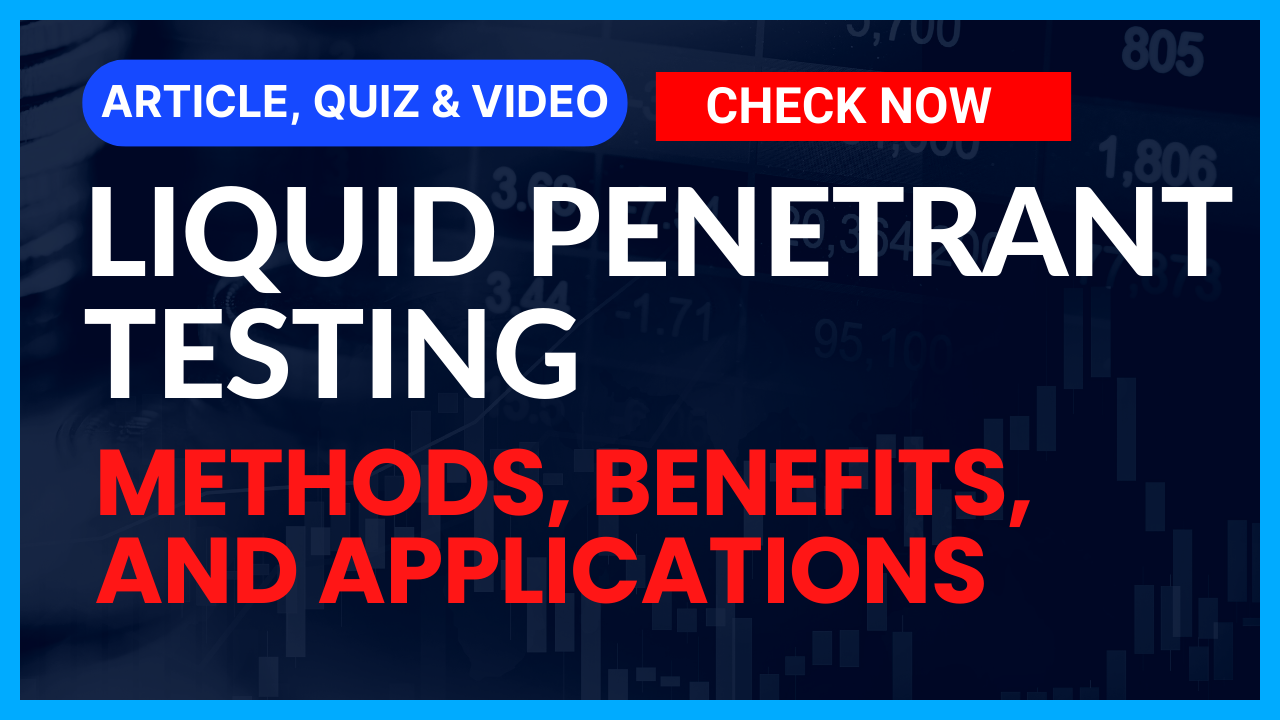Introduction
Liquid Penetrant Testing (PT) is one of the Non-destructive testing (NDT) which plays a crucial role in ensuring the integrity and safety of various structures and components. This technique is employed to detect surface-breaking defects in materials without causing any damage. In this article, we’ll delve deep into the world of Liquid Penetrant Testing, exploring its principles, procedures, applications, advantages, and limitations.
Table of Contents
Don’t miss the Complete Course on Piping Engineering: Check Now
By EPCLand.com
Understanding Liquid Penetrant Testing (PT)
Liquid Penetrant Testing, often referred to as dye penetrant testing, is a versatile NDT method used to detect defects such as cracks, porosity, laps, and other surface discontinuities in non-porous materials. The process involves the use of a liquid penetrant, which is applied to the surface of the material under inspection. The penetrant enters surface-breaking defects by capillary action, making them visible after the excess penetrant is removed and a developer is applied.
The Principle Behind Liquid Penetrant Testing
At the heart of Liquid Penetrant Testing lies the principle of capillary action and surface tension. When the liquid penetrant is applied to the material’s surface, it is drawn into any surface-breaking defects due to the capillary action. After a sufficient dwell time, the excess penetrant is removed, and a developer is applied, which pulls the trapped penetrant out of the defects and forms visible indications.
Procedure of Liquid Penetrant Testing
- Surface Preparation: The material’s surface is cleaned thoroughly to remove any contaminants that could hinder the penetration process.
- Penetrant Application: The liquid penetrant, often a brightly colored dye, is applied to the surface and allowed to dwell. The dwell time depends on the material and the size of defects being targeted.
- Excess Penetrant Removal: After the dwell time, excess penetrant is carefully removed from the surface, leaving behind only the penetrant trapped in defects.
- Developer Application: A developer, typically in powdered form, is applied to the surface. The developer draws out the trapped penetrant and forms visible indications.
- Indication Inspection: Trained inspectors examine the surface for indications. The characteristics of indications, such as size, shape, and color, provide valuable insights into the nature of defects.
- Interpretation and Reporting: Inspection results are analyzed, and a detailed report is generated, outlining the location, size, and type of defects found.
Applications of Liquid Penetrant Testing
Liquid Penetrant Testing finds applications across various industries, including:
- Aerospace: Detecting cracks in aircraft components.
- Manufacturing: Ensuring the quality of welded joints, castings, and forgings.
- Automotive: Inspecting critical components like engine blocks and gears.
- Oil and Gas: Examining pipelines, pressure vessels, and storage tanks for defects.
- Infrastructure: Testing bridges, buildings, and other structures for surface cracks.
Advantages of Liquid Penetrant Testing
- Sensitivity: Can detect very small defects that are not easily visible to the naked eye.
- Cost-Effective: Compared to other NDT methods, PT is relatively inexpensive.
- Versatility: Suitable for a wide range of materials, including metals, plastics, ceramics, and glass.
- Quick Results: The process provides rapid results, allowing for efficient decision-making.
- Easy to Learn: Training and certification for liquid penetrant testing are readily available.
Don’t miss the Complete Course on Piping Engineering: Check Now
By EPCLand.com
Limitations of Liquid Penetrant Testing
- Surface Defects Only: PT can only detect defects that are open to the surface.
- Human Interpretation: Inspection results require skilled human interpretation, which can introduce subjectivity.
- Surface Preparation: Proper cleaning is essential; contaminants can interfere with the process.
- Material Limitations: PT is most effective on non-porous materials; porous materials may not yield accurate results.
- Environmental Concerns: Some penetrants contain chemicals that can be harmful to the environment.
Pros and Cons of Liquid Penetrant Testing:
| Pros of Liquid Penetrant Testing | Cons of Liquid Penetrant Testing |
|---|---|
| High Sensitivity: Can detect very small defects that are not easily visible. | Surface Defects Only: Limited to detecting defects open to the surface. |
| Cost-Effective: Relatively inexpensive compared to other NDT methods. | Human Interpretation: Results require skilled interpretation, introducing subjectivity. |
| Versatility: Suitable for a wide range of materials, including metals, plastics, ceramics, and glass. | Surface Preparation: Proper cleaning is crucial; contaminants can hinder the process. |
| Quick Results: Provides rapid inspection outcomes, enabling efficient decision-making. | Material Limitations: Most effective on non-porous materials; porous materials may not yield accurate results. |
| Easy to Learn: Training and certification are readily available. | Environmental Concerns: Some penetrants contain chemicals harmful to the environment. |
FAQs (Frequently Asked Questions)
Q1: What materials can be inspected using Liquid Penetrant Testing? A: Liquid Penetrant Testing can be used on a wide range of materials, including metals, plastics, ceramics, and glass.
Q2: Is Liquid Penetrant Testing suitable for detecting internal defects? A: No, Liquid Penetrant Testing can only detect defects that are open to the surface.
Q3: How long does a typical Liquid Penetrant Testing process take? A: The duration varies based on factors such as the material, defect size, and specific procedure, but it generally provides quick results.
Q4: What safety precautions should be taken when working with liquid penetrants? A: Safety measures include proper ventilation, protective gear, and following manufacturer guidelines for handling and disposal.
Q5: Can Liquid Penetrant Testing replace radiographic inspection methods? A: Liquid Penetrant Testing and radiography serve different purposes. While PT is best for surface defects, radiography is used to inspect internal structures.
Conclusion
Liquid Penetrant Testing is a vital tool in the world of non-destructive testing, offering an efficient and cost-effective way to identify surface-breaking defects in various materials. From its underlying principles to its applications, advantages, and limitations, understanding the ins and outs of this method is essential for professionals working in industries that require rigorous quality control. By mastering Liquid Penetrant Testing, engineers and inspectors can contribute to safer and more reliable products and structures.
Recommended courses (Published on EPCLand)
- Basics of Piping Engineering
- Piping Layout Engineering
- Piping Material Engineering
- Piping Stress Analysis
- Complete Course on Piping Engineering
- Material Requisitions
- Piping Material Specifications
- Valve Material Specifications
Don’t miss the published articles on following:
Related Video
Attempt Quiz
Question 1:
What is the primary purpose of Non-Destructive Testing (NDT)?
Explanation: The primary purpose of NDT is to identify and evaluate manufacturing defects, discontinuities, or irregularities in materials and structures without causing damage to them.
Question 2:
Which of the following NDT methods uses sound waves to inspect materials?
Explanation: Ultrasonic Testing (UT) uses sound waves to inspect materials and detect defects such as cracks, voids, and internal inclusions.
Question 3:
Which NDT method involves applying a magnetic field to a ferromagnetic material?
Explanation: Magnetic Particle Testing (MT) involves applying a magnetic field and ferromagnetic particles to detect surface and near-surface defects in ferromagnetic materials.
Question 4:
What is the primary advantage of Radiographic Testing (RT) in NDT?
Explanation: Radiographic Testing (RT) is advantageous for its ability to detect internal defects in materials and provide detailed images of the internal structure.
Question 5:
Which NDT method involves applying a liquid to the surface of a material to detect surface defects?
Explanation: Liquid Penetrant Testing (PT) involves applying a liquid dye or penetrant to the surface of a material to detect surface defects that may not be visible to the naked eye.



